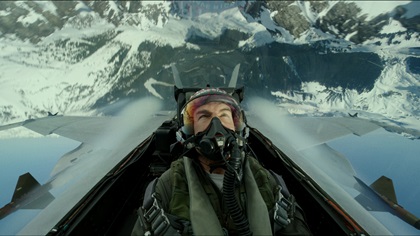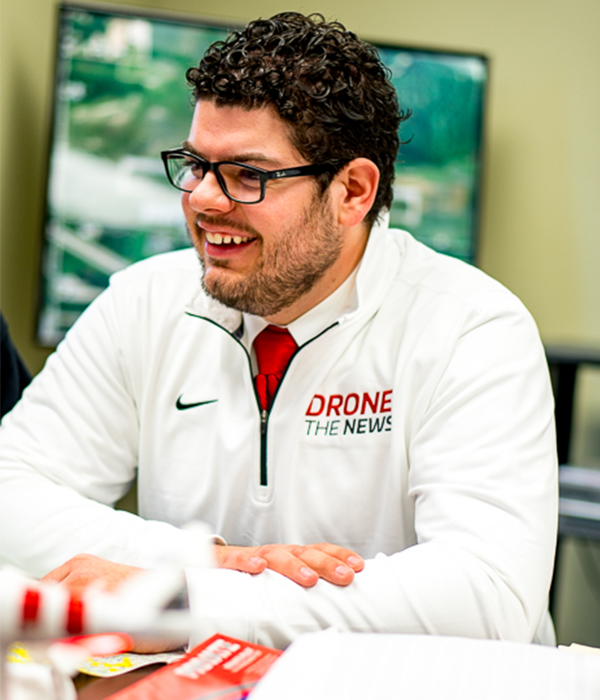As real as it gets
'Top Gun: Maverick' aerial action made by pilots
The realism of the dogfighting action in Top Gun: Maverick, the much-anticipated sequel to the 1986 blockbuster that launched many flying careers, military and otherwise, owes much to the new film's aerial coordinator, who helped train actors for their roles as pilots by making actual pilots out of them.
As aviation and air combat were developed during World War I, Hollywood was close behind. The 1927 film Wings included aerial combat action sequences (flown by World War I veterans) that set the standard of realism by which future aviation films were judged. (The film won the first Academy Award for Best Picture.)
Almost a century later, the same studio (Paramount) looks to raise the bar of air combat cinematography once again, with Top Gun: Maverick, scheduled for release May 27. The official trailer has logged nearly 25 million views since March, a promising sign from the studio's perspective, and many pilots have stated intentions to see it in the first week of the film's release.
Much like the groundbreaking silent film of the 1920s that featured hundreds of actual military aircraft furnished by the U.S. government, the studio once again turned to pilots, and the U.S. military, to make the on-camera aerial action in actual military aircraft—including F/A–18 Super Hornets—as real as possible.

'It shows so well'
Every aviation action sequence in the film is a choreographed dance, each move exquisitely timed and punctuated by the sound of jet engines. Cameras are everywhere, some clinging to the canopy of fighter jets, others mounted on custom-designed rigs carried by a highly customized Aero Vodochody L–39 Albatros dubbed the CineJet by its creator, Kevin LaRosa II, also known as "K2," the vice president of production at Helinet Aviation Services and an accomplished pilot who grew up in the business, learning about flying and filmmaking first from his father, also an accomplished aerial coordinator and pilot for film and television. (See additional photos and read excerpts from another interview with LaRosa in the "Return to the Danger Zone," June AOPA Pilot.)
The younger LaRosa is a third-generation pilot bringing the family business to new heights with his central role as aerial coordinator of the new film that aims to be a blockbuster. LaRosa's flying and camera work are at the heart of it all: He orchestrated every precise aerobatic maneuver, oversaw months of flight training for the on-screen actors, and scouted several locations where Top Gun: Maverick action sequences were captured.
LaRosa hopes you’ll leave the theater wondering if it was an actual flight or computer-generated imaging (CGI).
LaRosa said he would not, actually, be offended if you presume it must have been done on a computer: “That’s actually the biggest compliment we could ever receive.”
It all begins at a standstill. Before jets break the sound barrier and actors, including the film’s star Tom Cruise, begin dogfighting in actual warplanes, the crew hit the books. LaRosa and his father worked with Cruise (who is also a certificated pilot) and the production team to design an aviation curriculum that made the actors in the film into believable aviators.
“That's a huge testament to the production company, and to Tom,” said LaRosa. “To spend that expense and to go through the effort to do that. It shows so well on camera.”
As a ballet student starts learning by firmly gripping a handrail, the cast and crew of Top Gun: Maverick started training as many pilots do, in the left seat of a Cessna 172. The actors built fundamental skills and graduated from Skyhawks to an Extra Flugzeugbau EA300, adding high-G training and introducing the importance of breathing control to maintain consciousness.

LaRosa worked with the U.S. Navy to oversee the military's role in the film, including supplying the fighters. Cast and crew learned how to use ejection seats, and carrier operations.
“We were very keen on making sure that the talent was prepped and ready, and that they would really look like aviators,” said LaRosa.
Making the actors look like real aviators by making them real aviators was only part of the magic. Capturing carefully choreographed maneuvers for Top Gun: Maverick also required an array of cameras, both airborne and otherwise.
Aircraft action sequences in the film range from milliseconds to minutes long, but for LaRosa quantifying the time it took to capture that millisecond of action is nearly impossible: “So much thought went into the process to make sure that every single sequence we did was the most dynamic, energetic and breathtaking aerial.”
Long before actors buckled into warplanes, LaRosa had spent hours peering out the window of a helicopter, scouting terrain for filming locations where the lighting would be the most cinematic and rewarding for the big screen. “We did not want to settle for anything less than that. A painstaking process but extremely rewarding.”
Those painstaking location scouting sessions also informed hours of ground school on how to fly the terrain, and what to expect while maneuvering the aircraft. Once the cast and crew felt comfortable on the ground, they moved to the aerial work, starting slow and gaining speed with each attempt. As repetition grew, camera operators would start rolling the film until the perfect shot was captured.
The repetitive process, flying 10 "takes" or more of each maneuver, is nothing new for LaRosa, who served as the aerial coordinator for previous movies such as Iron Man, The Avengers, and Transformers. His life is rooted in aerial cinematic storytelling and his résumé is reminiscent of a pilot who is in their later years of life. Still in his mid-thirties, Kevin LaRosa is rated to fly more than 25 airplanes and helicopters, and holds airline transport pilot certificates for both fixed-wing and rotorcraft.
The passion to fly runs in his family. LaRosa grew up in a household where his father was a well-known Hollywood pilot with film credits including The Last Castle, Pearl Harbor, and Independence Day. Inspiration came right from the top for the younger LaRosa: “All I wanted to do is be like my dad.”
Kicked out of the nest
At a young age LaRosa would take to the skies with his father in their North American P–51 Mustang and T–6 Texan. Kevin LaRosa Sr. helped his son work to earn flight time and train as often as he could. It was a sense of creativity that inspired the younger LaRosa to follow his father's footsteps, soaring above the ground and watching his father gather content for cinematic storytelling.
From driving the fuel trucks to cleaning his dad’s helicopters, LaRosa was always on the flight line. Despite the younger LaRosa logging hundreds of hours flying airplanes and working hand in hand with his father, Kevin LaRosa Sr. did something that revolutionized his son's career: He kicked his son out of his airplanes. He knew that in order for his son to be a respected motion picture pilot in his own right, he would need to gain experience flying on his own in the real world.

Though frustrated, LaRosa listened to his father. "The guy is my hero and I trust him.” The young aviator left the comfort of working within the family business and described that as one of the pivotal moments in his career. “I’m glad I did because I don’t think I’d be where I am today, I wouldn’t have the experience I have today nor would I have the success in the industry that I’m in if I hadn’t taken that advice.”
LaRosa spent years flying a news helicopter in Los Angeles with reporters and camera operators aboard, gathering experience in some of the most congested airspace in the United States. His goal was to become the most well-rounded pilot that he could. "I know those hard days, those long days, where we’d have failures or mechanical problems was all experience that I was going to take with me.”
Tireless days turned into an opportunity for the eager pilot. Wolfe Air Aviation called looking for someone to operate the company’s Learjet 25B camera jet for air-to-air photography missions. Kevin accepted the role, where he met Tom McMurtry, a former Navy pilot who also flew for NASA and specialized in what LaRosa described as “non-standard stuff” in an aircraft.
It was LaRosa's big break, and McMurtry introduced LaRosa to the military way of flying jets, including particular aspects of preparation and risk management. “That was a huge part of my career in the building blocks of what I’ve become today,” LaRosa said.

'We're trying to sell beauty and gracefulness'
There is no standardized training for film and television pilots. LaRosa cites practicing excellence and repetition for making his flights successful, and LaRosa employs a crawl-walk-run approach to every scene. “Ripping through the streets and buildings is not on the first take. That’s not even the first day.”
LaRosa's crew will often practice days in advance, frequently shutting down city streets for safety. Multiple pilots stationed on the ground oversee every maneuver and communicate over radio frequencies to the pilots flying. Each maneuver is planned with precision, down to the smallest detail. Shifting a planned flight path by even a few feet is carefully considered. "It’s definitely not the Wild West, and it may look like we’re cranking and banking around but it's highly orchestrated.”
A recent production required LaRosa to land an MH-6 Little Bird helicopter on a moving train. He began his training by parking the helicopter atop a stationary box car and progressing to landing on a slow-moving train, followed by faster and faster speeds, culminating with a landing, with cameras rolling, on a fast-moving train.
The goal is to immerse the audience in the moment. “We’re trying to sell beauty and gracefulness,” LaRosa said. “You always want to be setting a new standard just to make things more edgy and kind of pushing the limits.”
LaRosa, along with other members of the Top Gun: Maverick production crew, believes computer-generated graphics can never replace that immersive experience on film when it comes to aviation action. LaRosa said 2022 will be a pivotal year in film as directors and producers see what is possible for practical flight stunts courtesy of films like Top Gun: Maverick and another forthcoming release, Devotion, the story of Navy fighter pilot Jesse Brown.
“It's this thrill ride for the viewer, and to know that everything they're looking at on the screen is real is a very cool feeling,” LaRosa said.
The 1986 release of Top Gun has been widely credited as one of the most successful Navy recruiting tools ever made, having moved many people to become pilots. That includes LaRosa himself, who strongly considered enlisting and working his way up through the ranks.
LaRosa is confident that the long-awaited sequel will be equally inspirational.
“I know that, just like the first movie, this will have a profound impact on the next three to four generations of naval aviators.”




